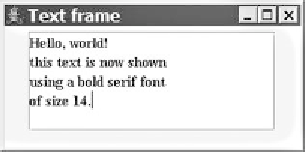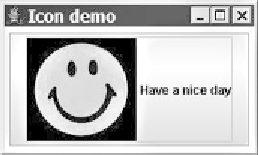Java Reference
In-Depth Information
discussed previously in Supplement 3G, fonts are represented by
Font
objects. A
Font
object can be constructed by passing its name, style (such as bold or italic), and
size in pixels. For example, the following line of code tells the text area to use a size
14 serifed font:
area.setFont(new Font("Serif", Font.BOLD, 14));
The text area now has the following appearance:
See Supplement 3G for a more lengthy discussion of
Font
objects.
Many Java components, including buttons and labels, have an icon property that can
be set to place an image on the component. This property is of type
Icon
.
The
getIcon
and
setIcon
methods use values that implement the
Icon
inter-
face. The easiest way to get an object that implements
Icon
is to create an object
of type
ImageIcon
. The
ImageIcon
constructor accepts a
String
parameter that
represents the image file to load. The image is a file on your hard disk, such as a
GIF, JPG, or PNG image. Place your image files in the same folder as your pro-
gram files.
The following code places an icon on a button. The icon image comes from a file
called
smiley.jpg
that has already been saved to the same folder as the code:
// create a smiley face icon for this button
JButton button = new JButton("Have a nice day");
button.setIcon(new ImageIcon("smiley.jpg"));
The screenshot that follows shows the appearance of the button when it is placed
in a frame. It is enlarged to accommodate both its text and its new icon:



Search WWH ::

Custom Search